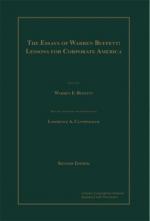
|
| Name: _________________________ | Period: ___________________ |
This test consists of 5 multiple choice questions, 5 short answer questions, and 10 short essay questions.
Multiple Choice Questions
1. Which of the partners had 99% of their net worth concentrated in Berkshire stock?
(a) Both.
(b) Buffett.
(c) Munger.
(d) Neither.
2. Berkshire's long-term investment strategy to buy and to hold _______ for the long term was something that was comfortable to them.
(a) Investments.
(b) Decisions.
(c) Stockholders.
(d) Buildings.
3. Value came from a fixed-income feature to set minimum value with __________ as a bonus.
(a) A good economy.
(b) A strong management team.
(c) A unique product.
(d) Conversion.
4. The permanent holdings at Berkshire were those that Buffett and Munger decided to keep, no matter what the _________ offered.
(a) Value.
(b) Name.
(c) Price.
(d) Options.
5. Buffett noted that a CEO had no direct ______ or clear standards of performance, making even under performing ones able to continue working.
(a) Workers.
(b) Authority.
(c) Responsibilities.
(d) Supervisor.
Short Answer Questions
1. The partners considered a lesser interest if the ________ price was less than what it would be for 100%.
2. What was the title of Buffett in relation to his company?
3. Below investment grade bonds are generally called ________, since they are able to be transformed.
4. In some cases, the benefits of partial ownership earnings may far outweigh the ________ acquisition cost.
5. What was the name of Warren Buffett's partner in the company they shared?
Short Essay Questions
1. Who did Buffett consider to be partners with him in his business, according to the book?
2. What did Buffett fear about investing in companies that were located in California?
3. What would business contraction cause, though Buffett says this was also an opportune time for investment?
4. How did Buffett seek to define a corporation as a mechanism? What exactly did this mean?
5. What was the key principle of Ben Graham that guided the way that Buffett bought other businesses?
6. Whose investing principles guided the Buffett purchase of Washington Post Company?
7. What might a CEO do if they were unlikely to dispose of their successful operating business, according to Buffett?
8. How did Buffett and Munger buy public companies, according to the book's details?
9. What were the five different categories from which Buffett can select his investments?
10. What was the concept of fallen angels, according to Buffett's lessons about investing?
|
This section contains 557 words (approx. 2 pages at 300 words per page) |

|




